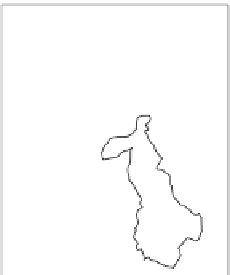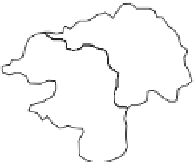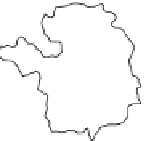Geography Reference
In-Depth Information
Input layer
Union layer
Output layer
Figure 5.2
Union operator.
A1
A1
A1,B2
B2
B2
A1,B1
B1
B1
A2,B2
A2
A2
A2,B1
Input layer
Union layer
Output layer
Figure 5.3
Union operator: transfer of attributes.
input layer and which is the union layer. h e operation corresponds to the Boolean
OR and is illustrated in Figure 5.2.
h e attributes from the two layers are joined as shown in Figure 5.3. In that case,
the i rst layer has polygons that each represent one attribute labelled A1 or A2.
Similarly, the polygons in the second layer represent attributes labelled B1 and B2.
In the output (union) layer those overlapping areas take both sets of attributes. In this
way, new polygons with particular combinations of attributes are generated. Of course,
each input polygon may contain many attributes, which will be transferred in the
same way.
Intersect overlays points, lines, or polygons on polygons but retains only those por-
tions of the input layer falling within the overlay (intersect) layer features. h e inter-
sect overlay corresponds to Boolean AND (for layers
A
and
B
, given by
A
«
B
) and is
illustrated in Figure 5.4.
For lines, line segments in the input layer that fall within the intersect layer are
retained. For points, those points in the input layer that are located within the intersect















Search WWH ::

Custom Search